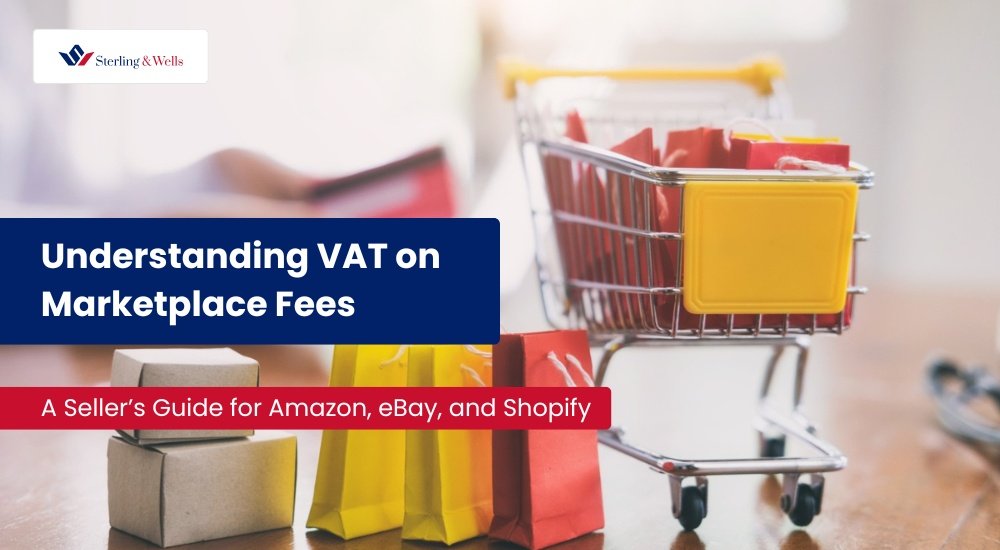VAT on UK Online Marketplace Fees: A Seller’s Guide for Amazon, eBay, and Shopify

If you’re selling online through platforms like Amazon, eBay, or Shopify, it’s important to understand how VAT applies to the fees you’re charged. The online marketplace fees—ranging from subscription costs to transaction and fulfillment charges—are often subject to VAT, but how it’s applied and reclaimed varies by platform and your VAT registration status.
This guide breaks down what UK sellers need to know about VAT on marketplace fees.
Amazon Seller Fees: VAT Now Charged Upfront
Since August 2024, Amazon has changed its VAT handling on seller charges. All Amazon fees now include 20% UK VAT for sellers operating under a UK VAT registration.
- Example: If Amazon charges a £100 fee for FBA services, the invoice will show £120 total (£100 + £20 VAT).
- UK VAT-registered sellers can reclaim the £20 as input VAT on their return, assuming a valid VAT invoice is available.
- Before August 2024, Amazon often issued invoices VAT-free using the reverse charge—that’s no longer the case for UK sellers.
Action
Make sure you collect Amazon fee invoices regularly and enter them correctly in your accounting software to claim input VAT.
eBay Seller Fees: VAT Applied by Default
eBay UK charges 20% VAT on most seller fees, including:
- Final value fees
- Listing and insertion fees
- Subscription plans
These VAT charges are clearly shown on eBay invoices and typically deducted from seller payouts.
- VAT-registered sellers: You can reclaim this VAT as input tax when filing your return, just like any other business expense.
- Non-VAT-registered sellers: You will absorb the VAT as part of the total fee cost.
Action
Keep eBay fee invoices organized. If you use accounting tools (e.g., Xero, QuickBooks), ensure the VAT portion is allocated correctly for reclaim.
Shopify Fees: Reverse Charge for VAT-Registered Sellers
Shopify, headquartered in Ireland, handles VAT differently. For UK VAT-registered merchants, Shopify typically does not charge VAT on subscription and transaction fees. Instead, the reverse charge mechanism applies.
- You (the seller) must self-account for VAT:
- Calculate 20% VAT on the Shopify fees.
- Report that VAT as both output tax (Box 1) and input tax (Box 4)—resulting in no net VAT due.
- For sellers not registered for UK VAT, Shopify will charge Irish VAT (which is currently 23%) directly on its fees. This can not be claimed back by the UK unregistered VAT customer.
Action
Make sure your Shopify billing profile includes your UK VAT number. Record reverse-charge entries properly in your VAT returns.
VAT on Fees: Key Takeaways for Online Sellers
Regardless of the platform, VAT on seller fees is a business expense—and usually reclaimable by VAT-registered UK sellers. Here’s how to stay compliant:
- Always collect and store valid VAT invoices from your platforms.
- Use automated accounting software or marketplace to simplify VAT tracking.
- For reverse-charge scenarios (like Shopify), make sure you’re accounting for both output and input VAT correctly.
Conclusion: Stay VAT-Savvy to Protect Your Margins
VAT on marketplace fees isn’t an added cost if handled correctly—it’s simply part of the tax system. For UK VAT-registered sellers, reclaiming VAT on Amazon, eBay, and even reverse-charged Shopify fees helps maintain profitability and accurate financial records.
By understanding each platform’s VAT treatment and integrating your invoicing with smart accounting tools, you’ll stay compliant and avoid costly mistakes. As platforms evolve, staying updated on VAT changes is essential for scaling your eCommerce business smoothly.
Prasun
Prasun Shrestha is a specialist in accounting and taxation and has served numerous clients based inside and outside UK achieve regulatory compliance and optimal performance.